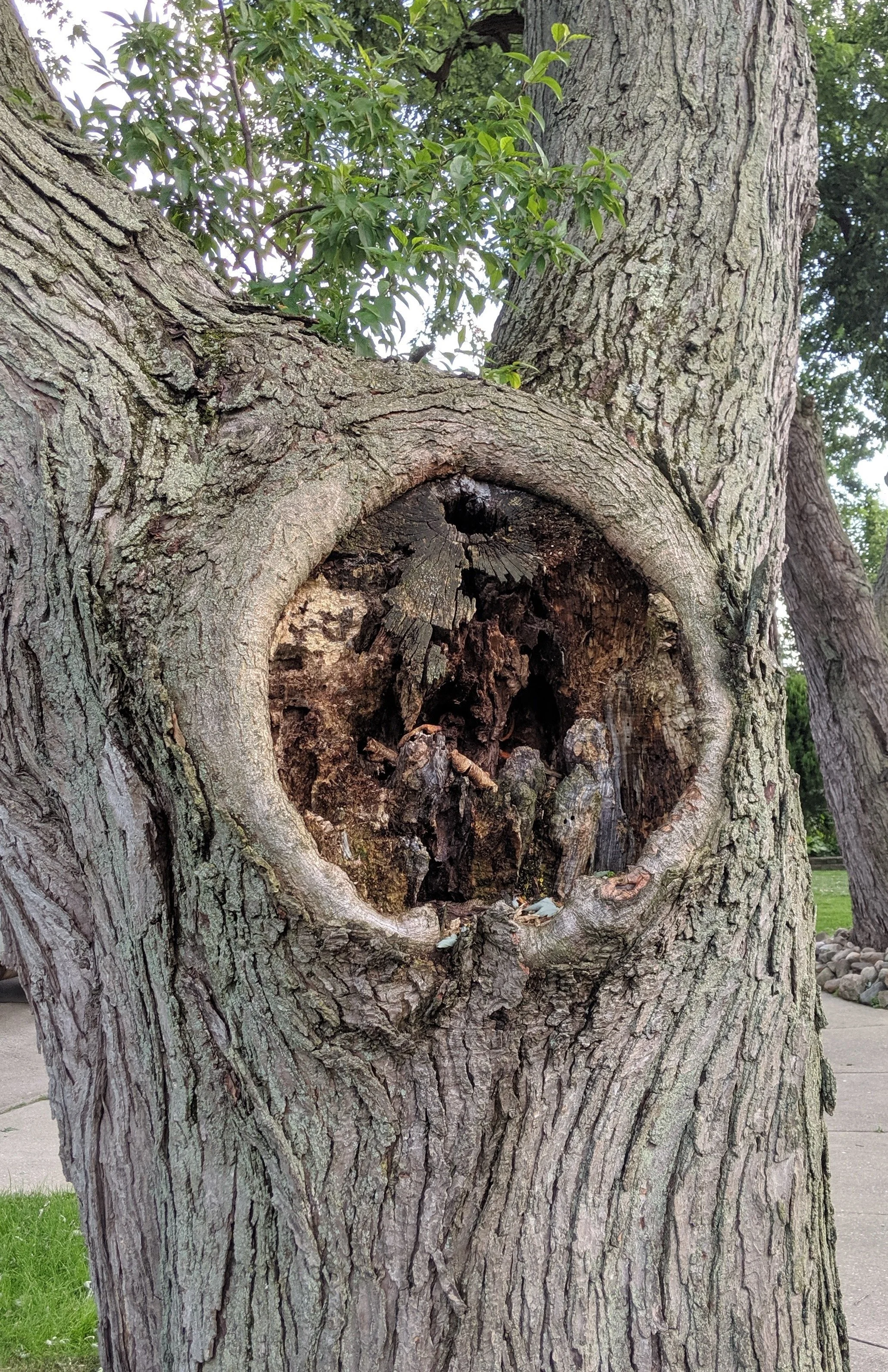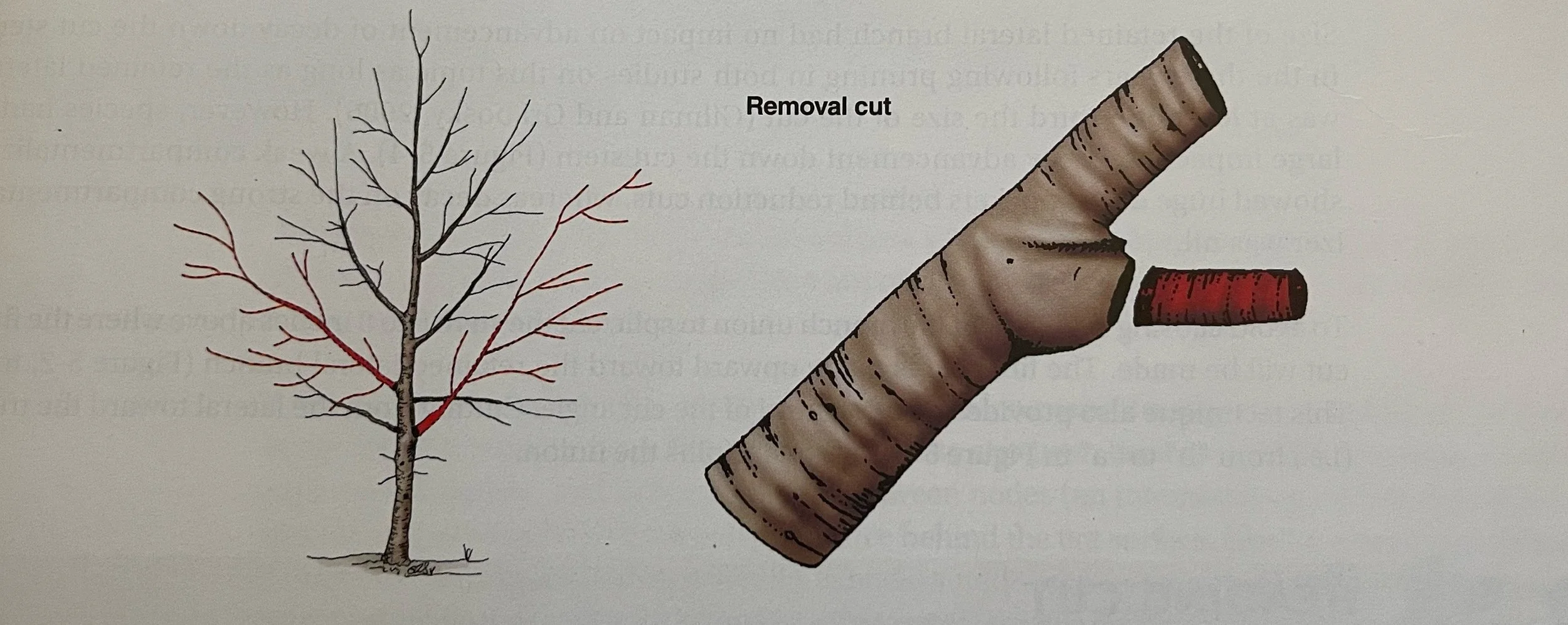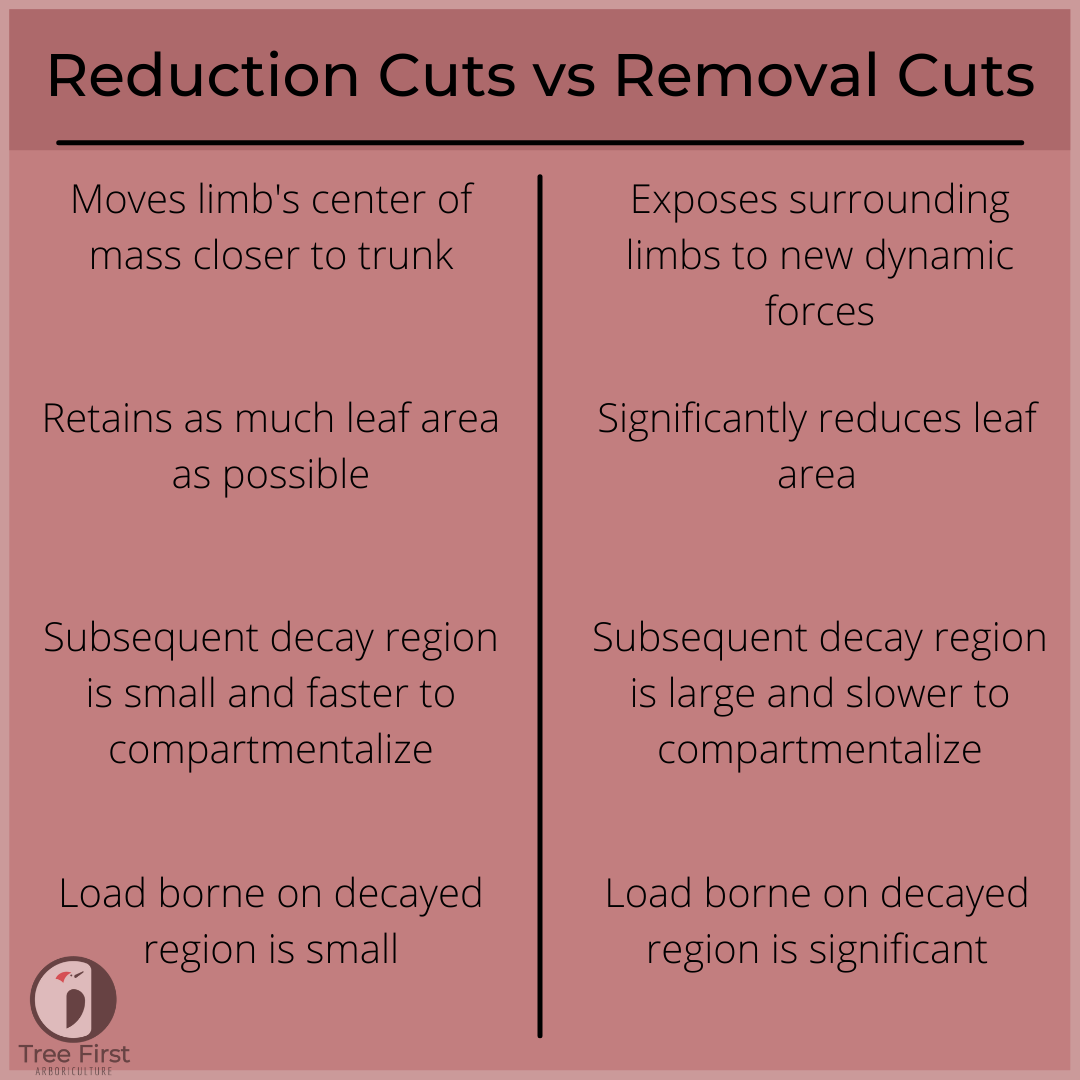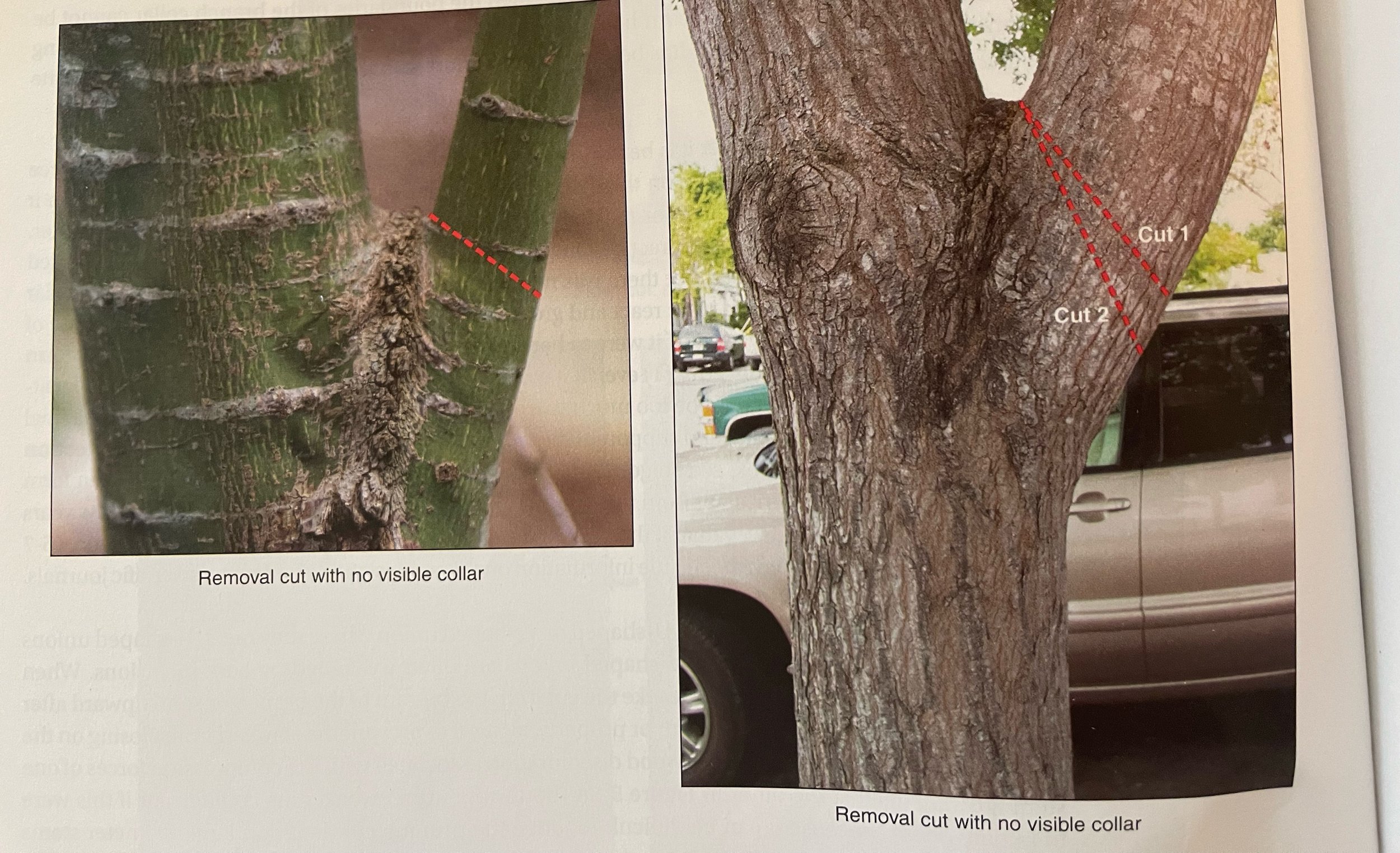*Jeremiah originally wrote this article for the Tree Care Industry Magazine. It was first published in the April, 2022 issue under the same title.*
Where to put Decay in Trees
Any time a living part of a tree is cut open through pruning, or broken open through storm damage, the remaining area will decay. This article presents a way to think of pruning as ‘where to put decay into the tree’.
Remnants of a living stem removed from a tree by cutting. Saint Clair Shores, MI
Most of us working in arboricultural or horticultural fields are aware of a principle known as the compartmentalization of decay (or dysfunction) in trees, abbreviated as CODIT. In short, the principle describes how woody plants will encase dysfunctional tissue within functional tissue in order to prevent the spread of the dysfunction.
This article is neither a history lesson nor a refresher on the CODIT model, though this article is predicated on the reader having a base understanding of the theory. Alex Shigo’s CODIT model has largely influenced the way modern arboriculture is practiced in the United States. While it isn’t a complete model, it has remarkably improved the way trees have been pruned since the theory’s publishing.
Shigo’s model has led to the development of a “proper cut”, and it is the first thing any arborist or tree cutter learns before working a tree.
The idea is that this cut best positions the tree to enclose the decayed area as quickly as possible while minimizing damage to the surrounding tissue left on the tree.
Knowing how to make the cut isn’t enough; we have to zoom out. The importance of where the cut is being made on the tree is extremely understated: It is of the utmost importance in the long-term management of urban trees.
Going back to the CODIT principle: The area where the cut limb used to be attached to its parent stem will subsequently decay until the tree can enclose the decayed region. This means another way to consider pruning is not only where to make cuts, but also where we are putting decay into the tree.
Decay
Briefly, decay is facilitated primarily by fungi. Any time a living part of a tree is cut open through pruning, or broken open through storm damage (or embolism or cavitation), the remaining area will decay. Trees decay with or without human intervention.
Decay is complicated and is worthy of volumes of textbooks; it takes many forms and varies significantly. Its ecological and economical importance cannot be overstated. From hereon, we will operate under this simplified definition of dysfunctional/decayed wood:
Wood that is undergoing decomposition.
Wood undergoing decomposition functions physiologically and structurally at decreasingly suboptimal levels. For the purpose of this article, this definition encompasses decay at all magnitudes and includes decay of all origins. In this article, we also assume that large decayed regions in trees, while valuable for wildlife habitat, are best avoided in the management of urban trees next to immovable structures, such as human homes.
Two Types of Cuts
Reduction Cuts vs. Removal Cuts
There are many different types of cuts on trees, each has a pattern of aftermath that is recognizable. From old school workers to new school workers, practitioners of tree cutting or arboriculture will utilize two common cuts. Dr. Ed Gilman, renowned horticulture educator and author to many academic pruning books and studies, defines the two cuts below.
Reduction Cut:
A reduction cut reduces the length of a stem or branch by removing the terminal portion back to a living lateral branch of equal or smaller diameter.
Image from Gilman’s An Illustrated Guide to Pruning 3rd Edition
Removal Cut:
...removes a branch back to its parent stem or trunk and retains the collar… In contrast to a reduction cut, the part of the plant that remains following a removal cut has a larger diameter than the part that was removed. Examples include removing a limb from the trunk...
Image from Gilman’s An Illustrated Guide to Pruning 3rd Edition
Removal cut considerations
A tree’s capacity to compartmentalize wounds diminishes as the cut sizes increase, regardless of the type of cut being made. Removal cuts are generally larger than reduction cuts, and the placement of their subsequent decay is much more detrimental than reduction cuts. This is because the loads borne on the decayed regions in the trunk following large removal cuts are much greater than loads borne out on the periphery of the crown.
It is important to admit sometimes full limb removal is the only effective cut for a given scenario. However, it absolutely should not be the preferential cut like it is today. Even with the use of the proper cut, the “minimized” damage done to the tree as a result, with the subsequent loss of strength in the future, is far too great for urban trees. There are almost always opportunities to make reduction cuts and mitigate risks in other ways.
Graphic by Tree First. Summarizing the differences between reduction and removal cuts.
Where to put decay
When it comes to pruning mature or large trees, the use of large removal cuts, especially against the trunk, should be avoided wherever possible because of the subsequent decay (and therefore loss of cross sectional strength) that will develop afterwards.
Image from Gilman’s An Illustrated Guide to Pruning 3rd Edition
Both of the cuts pictured above qualify as removal cuts by Gilman’s definition. The relationship of the diameters is meaningful only up to a certain point.
The image on the left shows a trunk:stem ratio of ~4:1 on a small stem. The resulting decay region will be minimal relative to the stem it is within. The image on the right shows a trunk:stem ratio of ~1.25:1. In proportion to its parent stem, the removed stem is nearly the same diameter. Given the size of the stems (~12 inches) pictured on the right above, this cut should be avoided.
The resulting decay region would greatly compromise this tree’s structure, as now the remaining stem bearing all of the crown has decreasingly reduced cross-sectional strength as it decays. Given that most urban trees do not have the resources available to their forest-dwelling counterparts, we are to assume that this example tree is not operating at “full capacity”. The rate of decay almost always exceeds the rate of compartmentalization of larger diameter pruning wounds, meaning the wound will never close. It ultimately results in a significantly sized hollow, and loss of stem strength/flexibility.
Other factors which influence the avoidance of this cut are the placement of the tree in a parking lot with many targets, and the already present (and possibly compartmentalized) decay from the previous pruning wound in that area.
Size of the cut, or rather the size of the future decay, needs to be the primary deciding factor on if a cut should be made or not when removing large limbs from trunks if we’re really working for the trees. The future load on the decayed region, the tree’s species & life stage, the tree’s exposure, targets around the tree, and how the tree or limb’s center of mass will be affected, are all things to consider when placing decay in a tree.
Aftermath of large removal cuts on mature urban trees
Jeremiah’s hand in relation to a highly decayed region resulting from the large removal of a living stem. Saint Clair Shores, MI.
These man-made hollows are often the breaking point for future storm failures. The image above is of a highly decayed region that resulted from a large removal cut of a swamp maple (Acer saccharinum). Notice how the decayed area is crumbling, even though this cut appears to have been properly made. As this continues to decay, it will not provide a solid surface for the tree to compartmentalize around, and thus never will close.
The subsequent decay after pruning is not a negligible byproduct. You can’t have the pruning cut without the decay; they are inseparable. That decay will be present in the tree for the remainder of its life, even if the tree compartmentalizes it.
Many pruning cuts compartmentalize totally fine, and hollows can form naturally. It just so happens that a large proportion of hollows found in urban trees are a direct result of pruning excessively large limbs off of trees that cannot handle it. This article isn’t claiming all removal cuts are bad. Certainly there are reduction cuts that result in significant hollows as well; just fewer of them.
Context matters: what are the goals of the project? To meet certain wildlife requirements, large removal cuts may be perfectly acceptable in a veteranization project where a hollow is the intended outcome. But the point remains, knowing how to make the cut is not enough. Just because the cut can be properly made, does not mean it should. Knowing what happens to the tree as a result of our work is paramount and must not be ignored. What will happen years after you make your cut?
Responsibility for the Future
Jeremiah performing an inspection of an old cut with a resistograph. The cut was made approximately 20 years prior, according to the homeowner. The result of this old cut has increased the possibility of the remaining stems failing. Royal Oak, MI.
When a customer is shopping for quotes, there’s nothing that stands out about a salesman who says yes to everything. An arborist who can speak clearly about risk mitigation and long-term strategies for their tree has a significant competitive advantage over someone who still needs their spurs to prune.
We have to zoom out. We have to explain these concepts to our customers. The ‘customer is always right’ method is losing out to the ‘tree first’ method. What the customer actually wants is the information in order to make the best decisions for their trees.
It might even be useful to assume any large removal cut made on a mature tree will not compartmentalize–to assume that a hollow will form. This way we are always going to opt for the option that leaves the least amount of decay. Considering ‘where to put decay’ while pruning ensures we are thinking of the tree’s future.
It is entrusted to us arborists, first and foremost, to be the arbiter for trees in their preservation. If not us, then who?







